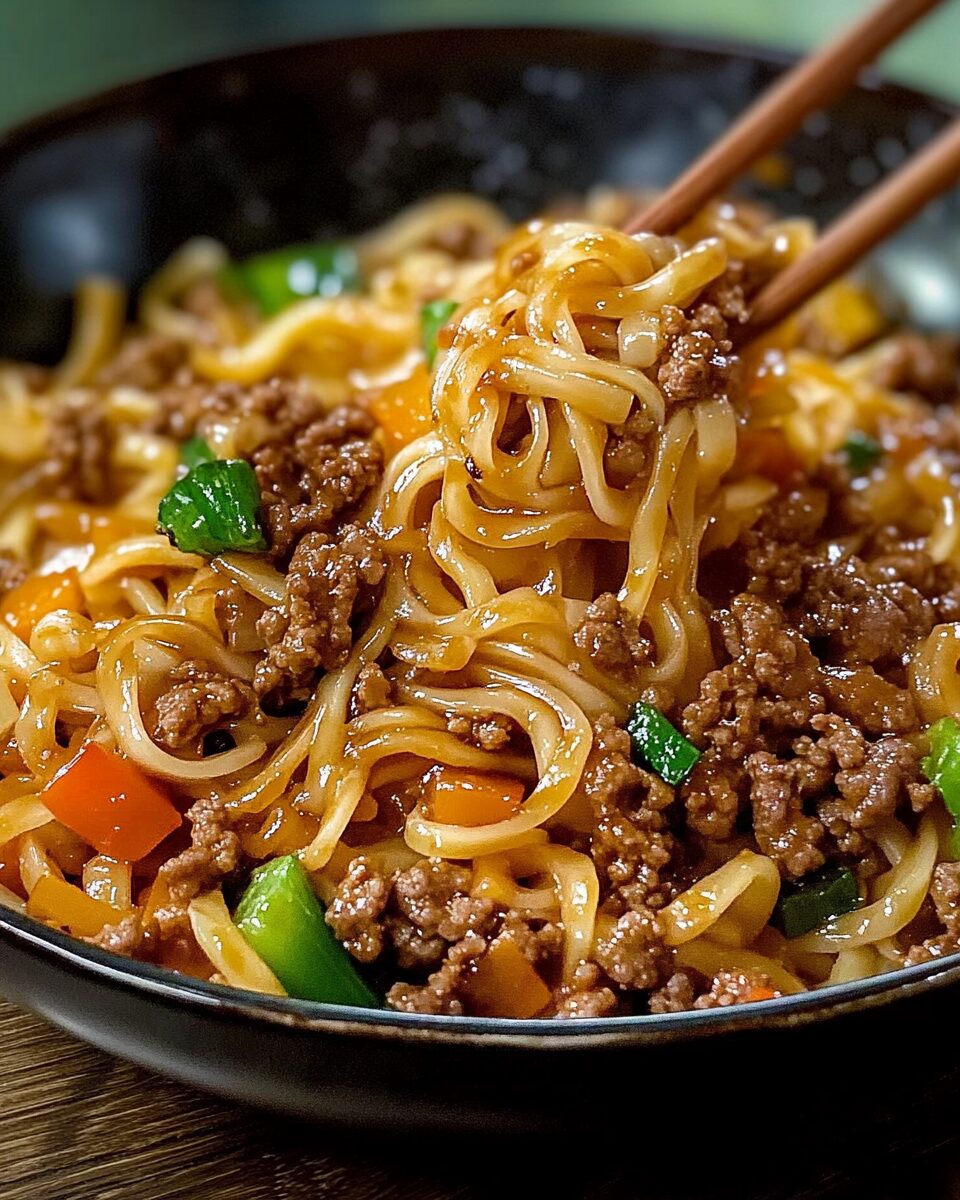Mongolian Ground Beef Noodles are a delightful fusion of savory, sweet, and spicy flavors that make for a quick and comforting meal. The combination of tender ground beef, aromatic garlic, and a rich sauce that coats every strand of linguine creates an irresistible dish that is sure to please both kids and adults. With a sprinkle of green onions, this meal not only tastes delicious but looks vibrant and appetizing.
Perfect for busy weeknights, this dish comes together in just 30 minutes. The beauty of this recipe lies in its versatility—whether you like it spicy with an extra dash of red pepper flakes or prefer a more savory balance with soy sauce and hoisin, you can easily adapt it to suit your taste. Serve it with a side of steamed vegetables or a simple salad for a complete meal that’s both satisfying and easy to prepare.
Full Recipe:
- 1 lb ground beef
- 5 cloves garlic, minced
- 1/3 cup brown sugar
- 1/4 cup beef broth
- 1/3 cup soy sauce
- 3 tablespoons hoisin sauce
- 1/2 teaspoon ground ginger
- 1/2 teaspoon ground black pepper
- Pinch of red pepper flakes (optional for a spicy kick)
- 10 oz linguine
- 1 tablespoon cornstarch
- 2 tablespoons water
- 4 green onions, sliced for garnish
Directions:
- Cook the Pasta: Start by cooking the linguine according to the package instructions in a large pot of boiling water. Once cooked, drain the pasta and set it aside.
- Brown the Ground Beef: In a large skillet over medium-high heat, brown the ground beef until it’s no longer pink. Drain any excess fat as needed.
- Add Aromatics and Sauces: Add the minced garlic to the browned beef and cook until fragrant, about 1 minute. Pour in the soy sauce, beef broth, brown sugar, hoisin sauce, ground ginger, black pepper, and red pepper flakes if using. Stir well to combine.
- Thicken the Sauce: In a small bowl, mix the cornstarch with cold water until smooth. Stir this mixture into the skillet with the beef and sauce. Allow it to simmer until the sauce thickens to your desired consistency.
- Combine with Noodles: Add the cooked and drained linguine to the skillet with the beef and sauce. Toss everything together until the noodles are fully coated with the flavorful sauce. Let them simmer together for a few minutes.
- Garnish and Serve: Sprinkle sliced green onions over the noodles for garnish. Serve hot and enjoy!
Prep Time: 10 minutes | Cooking Time: 20 minutes | Total Time: 30 minutes
Kcal: Approximately 650 kcal per serving | Servings: 4 servings
Recipe Origins and Inspirations
Mongolian cuisine is known for its hearty, flavorful dishes often featuring meat and robust sauces. This Mongolian Ground Beef Noodles recipe draws inspiration from traditional Mongolian beef dishes, which typically combine soy sauce, garlic, and ginger to create a rich, savory sauce. While not strictly authentic to Mongolian cuisine, this recipe captures the essence of those bold flavors in a quick and easy noodle dish that fits seamlessly into a modern kitchen routine.
Recipe Customizations and Variations
One of the best aspects of this recipe is its versatility. Here are some ways you can customize it:
- Vegetarian Option: Substitute the ground beef with crumbled tofu, tempeh, or a plant-based ground meat alternative. Add extra vegetables like bell peppers, snap peas, or broccoli for added texture and flavor.
- Protein Variations: Swap the ground beef for other proteins like thinly sliced chicken breast, shrimp, or even sliced flank steak to change up the flavor profile while keeping the dish delicious and satisfying.
- Spice Level: Adjust the heat by adding more red pepper flakes, sriracha, or sliced fresh chili peppers. If you prefer a milder dish, omit the red pepper flakes altogether.
- Noodle Options: While linguine works perfectly, you can use any noodle you have on hand. Spaghetti, rice noodles, or even ramen can be great substitutes. Adjust the cooking time based on the noodle type.
- Gluten-Free Adaptation: To make this dish gluten-free, use gluten-free soy sauce (tamari) and ensure that the hoisin sauce and noodles are also gluten-free varieties.
Serving Suggestions
This noodle dish can stand alone as a complete meal, but pairing it with complementary sides can elevate the dining experience:
- Steamed Vegetables: Serve alongside a medley of steamed vegetables like broccoli, carrots, or bok choy to add a nutritious component.
- Asian-Inspired Appetizers: Consider serving with egg rolls, potstickers, or a simple cucumber salad to create an Asian-inspired meal.
- Family-Style Presentation: For a casual and communal dining experience, present the noodles in a large serving dish, allowing everyone to serve themselves.
Storage and Meal Prep Tips
- Refrigeration: Store leftovers in an airtight container in the refrigerator for up to 3-4 days. The noodles and beef sauce reheat well, making this dish perfect for meal prep.
- Freezing: For longer storage, you can freeze the noodles and sauce. Place them in a freezer-safe container or resealable bags and freeze for up to 2-3 months. Thaw overnight in the refrigerator before reheating.
- Reheating: Reheat the noodles on the stovetop over medium heat, adding a splash of water to prevent drying out. Alternatively, use the microwave, ensuring the noodles are evenly heated.
Nutritional Information and Health Benefits
Each serving of Mongolian Ground Beef Noodles contains approximately 650 kcal. While this dish is on the indulgent side due to the rich sauce and noodles, it’s packed with protein and can be balanced with the addition of vegetables. Using lean ground beef or substituting with a plant-based protein can make this dish a healthier option without compromising on flavor. The use of garlic and ginger not only adds depth to the dish but also provides health benefits like boosting the immune system and aiding digestion.
Pairing Ideas
- Beverage: Pair this dish with a light, refreshing drink like jasmine iced tea or a citrusy sparkling water to balance the rich flavors.
- Dessert: For a sweet finish, serve a light dessert like green tea ice cream or fresh fruit salad to complement the savory noodles.
Cultural Context and Fusion Flavors
While this dish draws inspiration from Mongolian cuisine, it’s more accurately a fusion recipe combining elements of Asian flavors, particularly those found in Chinese-American dishes. The savory and sweet combination of soy sauce, hoisin sauce, and brown sugar gives it a taste profile similar to popular Mongolian beef dishes found in many Westernized Asian restaurants. By adding noodles to the mix, this recipe creates a hearty, comfort food experience reminiscent of classic takeout meals but with a homemade twist.
Cooking Tips and Tricks
- Perfectly Cooked Noodles: To prevent the noodles from sticking together, cook them in a large pot of boiling water with a pinch of salt. Stir occasionally and drain promptly once they’re al dente. You can toss the cooked noodles with a tiny bit of oil to keep them from clumping if they’re not being used immediately.
- Browning the Beef: For the best flavor, brown the ground beef well before adding the sauces. Browning creates a rich, caramelized flavor that enhances the overall taste of the dish. Use a large skillet to give the beef enough space to cook evenly without steaming.
- Thickening the Sauce: Mixing cornstarch with cold water ensures it dissolves completely, preventing lumps in the sauce. Add the cornstarch mixture slowly to the simmering sauce while stirring constantly until it thickens. If you prefer a thicker sauce, add a bit more cornstarch mixed with water.
- Enhancing Umami: To deepen the umami flavor, add a splash of oyster sauce or a small amount of fish sauce to the sauce mixture. These ingredients add depth and complexity to the dish.
Dietary Adjustments and Alternatives
- Low-Carb Option: For those following a low-carb or keto diet, substitute the noodles with spiralized zucchini (zoodles) or shirataki noodles. Adjust the sauce by reducing the brown sugar or using a sugar substitute to keep the carb count low.
- Lower Sodium: If you’re watching your sodium intake, use low-sodium soy sauce and beef broth. You can also reduce the amount of soy sauce used and add a bit of water or extra broth to maintain the sauce consistency.
- Allergy-Friendly Adjustments: For those with soy allergies, replace soy sauce with coconut aminos or a soy-free alternative. Ensure all other ingredients, like hoisin sauce, are free from allergens that need to be avoided.
How to Make It a Complete Meal
While this dish is delicious on its own, here are a few ways to turn it into a balanced, complete meal:
- Add Vegetables: Incorporate vegetables like bell peppers, carrots, snap peas, or baby spinach directly into the skillet with the beef and sauce. This not only adds color and texture but also boosts the nutritional value of the meal.
- Serve with a Side: Pair the noodles with a light side dish, such as a simple cucumber salad with a tangy sesame dressing, steamed edamame, or a bowl of miso soup to round out the meal.
- Protein Boost: For a more protein-packed version, add a fried or poached egg on top of the noodles. The runny yolk creates an extra layer of richness when mixed into the noodles.
Flavor Enhancements
- Herbs and Aromatics: Add a handful of fresh herbs like cilantro or Thai basil at the end of cooking for a burst of freshness. You can also include a squeeze of lime juice or a drizzle of sesame oil just before serving to brighten up the flavors.
- Texture Additions: To introduce some crunch, sprinkle toasted sesame seeds or crushed peanuts on top of the finished dish. These toppings not only add texture but also complement the savory-sweet flavor profile with their nutty undertones.
Cooking for a Crowd
This recipe scales easily for larger groups, making it ideal for family gatherings or casual dinner parties:
- Double the Recipe: Simply double the ingredients to serve a larger crowd. Use a large pot to cook the noodles and a bigger skillet or wok to stir-fry the beef and combine everything without overcrowding the pan.
- Buffet-Style Serving: Serve the Mongolian Ground Beef Noodles buffet-style with an array of toppings, such as sliced green onions, chili flakes, sesame seeds, and lime wedges, allowing guests to customize their plates.
- Pre-Cooking and Reheating: Prepare the dish in advance and store it in an oven-safe dish. Reheat in the oven at a low temperature (around 300°F) covered with foil until warmed through. Add a splash of water or broth if the noodles seem dry.
Historical and Nutritional Insight
While not a traditional Mongolian dish, this recipe shares similarities with stir-fried noodles found across various Asian cuisines, especially Chinese and Korean dishes. Historically, Mongolian cuisine has been based on meat and dairy, reflecting the nomadic lifestyle of its people. In this recipe, the use of beef pays homage to that tradition while blending it with modern, accessible ingredients like soy sauce and hoisin.
Nutritionally, this dish offers a well-rounded meal with protein from the beef, carbohydrates from the noodles, and the potential for added vitamins and minerals if vegetables are included. While it is indulgent due to the sauce’s sugar and sodium content, it’s balanced by the opportunity to customize it with lean proteins and fresh ingredients.
Conclusion
Mongolian Ground Beef Noodles offer a quick, flavorful, and versatile dish that’s perfect for busy weeknights or casual gatherings. With its savory, sweet, and spicy blend, it’s easily customizable to suit various dietary preferences. Whether you enhance it with veggies, adjust the spice level, or experiment with different proteins, this recipe is a crowd-pleaser that combines comfort and convenience. Enjoy it fresh, customize it to your liking, and make it a staple in your meal rotation for an easy yet satisfying homemade experience.






